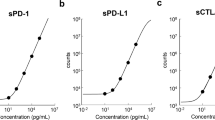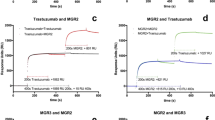Abstract
Elotuzumab is a first in class humanized IgG1 monoclonal antibody for the treatment of multiple myeloma (MM). Elotuzumab targets the glycoprotein signaling lymphocyte activation molecule family 7 (SLAMF7, also described as CS1 or CRACC) which is expressed on the surface of myeloma cells and a subset of immune cells, including natural killer cells. A soluble version of SLAMF7 (sSLAMF7) has also been reported in MM patients but has not been evaluated as a potential biomarker following therapeutic intervention. In order to measure serum levels of sSLAMF7, two immunoassays were developed to monitor changes in circulating sSLAMF7 before and after elotuzumab treatment. Free (drug-unbound) and total (drug-bound and unbound) electrochemiluminescence (ECL) ELISA assays were developed and validated following a fit for purpose (FFP) methodology. Both assays met analytical acceptance criteria for precision, drug interference, dilution linearity, spike recovery, parallelism, and stability. Both exhibited the range and sensitivity necessary to measure clinical samples with an LLOQ of 51.2 pg/mL and ULOQs of 160 (free) and 800 ng/mL (total). Previously described assays were unable to detect sSLAMF7 in healthy individuals. However, due to the increased sensitivity of these new assays, low but measurable sSLAMF7 levels were detected in all normal healthy sera evaluated and were significantly elevated in MM patients. Cohort statistics revealed a significant increase of circulating sSLAMF7 in MM patients versus normal controls and both significant decreases in free and increases in total levels of protein post-elotuzumab treatment.









Similar content being viewed by others
REFERENCES
American Cancer Society. Cancer facts & figures 2016. Atlanta; 2016.
Blade J, Rosinol L. Complications of multiple myeloma. Hematol Oncol Clin North Am. 2007;21(6):1231–46. xi.
Hsi ED, Steinle R, Balasa B, Szmania S, Draksharapu A, Shum BP, et al. CS1, a potential new therapeutic antibody target for the treatment of multiple myeloma. Clin Cancer Res. 2008;14(9):2775–84.
Veillette A, Guo H. CS1, a SLAM family receptor involved in immune regulation, is a therapeutic target in multiple myeloma. Crit Rev Oncol Hematol. 2013;88(1):168–77.
Tai YT, Dillon M, Song W, Leiba M, Li XF, Burger P, et al. Anti-CS1 humanized monoclonal antibody HuLuc63 inhibits myeloma cell adhesion and induces antibody-dependent cellular cytotoxicity in the bone marrow milieu. Blood. 2008;112(4):1329–37.
Balasa B, Yun R, Belmar NA, Fox M, Chao DT, Robbins MD, et al. Elotuzumab enhances natural killer cell activation and myeloma cell killing through interleukin-2 and TNF-alpha pathways. Cancer Immunol Immunother. 2015;64(1):61–73.
Collins SM, Bakan CE, Swartzel GD, Hofmeister CC, Efebera YA, Kwon H, et al. Elotuzumab directly enhances NK cell cytotoxicity against myeloma via CS1 ligation: evidence for augmented NK cell function complementing ADCC. Cancer Immunol Immunother. 2013;62(12):1841–9.
Lee JW, Devanarayan V, Barrett YC, Weiner R, Allinson J, Fountain S, et al. Fit-for-purpose method development and validation for successful biomarker measurement. Pharm Res. 2006;23(2):312–28.
Lee JW, Kelley M, King LE, Yang J, Salimi-Moosavi H, Tang MT, et al. Bioanalytical approaches to quantify “total” and “free” therapeutic antibodies and their targets: technical challenges and PK/PD applications over the course of drug development. AAPS J. 2011;13(1):99–110.
Postelnek JSJ, Keller S, Pazina T, Sheng J, Poulart V, Robbins M. Effects of elotuzumab on soluble SLAMF7 levels in multiple myeloma. Blood. 2015;126:2964.
CLSI. Procedures for the collection of diagnostic blood specimens by venipuncture: approved standard—sixth edition. CLIS document H3-A6. Wayne: Clinical Standards Laboratory Institute; 2007.
Meso Scale Diagnostics. MSD SULFO-TAG NHS-Ester. Gaithersburg: Meso Scale Diagnostics, LLC; 2011.
Do T, Ho F, Heidecker B, Witte K, Chang L, Lerner L. A rapid method for determining dynamic binding capacity of resins for the purification of proteins. Protein Expr Purif. 2008;60(2):147–50.
Frenzel D, Willbold D. Kinetic titration series with biolayer interferometry. PLoS One. 2014;9(9), e106882.
SurModics. StabilCoat® and 5X StabilCoat® Immunoassay Stabilizer 2011.
Anderson G, Scott M. Determination of product shelf life and activation energy for five drugs of abuse. Clin Chem. 1991;37(3):398–402.
Kopnitsky ML, Langer B. Use of SeraSub as a serum diluent in the manufacturing of ELISA controls. CST Technologies, Inc.; [cited 2016 February 18]. Available from: http://www.cstti.com/index.php/scientificpapers/paper2.html.
Draper NR, Smith H. Applied regression analysis. 2nd ed. New York: John WIley & Sons; 1981.
Westgard JO. Basic method validation: training in analytical quality management for healthcare laboratories. 3rd ed. Westgard Quality Corporation; 2008.
Milliken GA. Analysis of messy data, volume 1: designed experiments. CA: Wadsworth Inc.; 1984.
Deming WE. Statistical adjustment of data. New York: John Wiley and Sons; 1943.
Linnet K. Evaluation of regression procedures for methods comparison studies. Clin Chem. 1993;39(3):424–32.
ACKNOWLEDGMENTS
The authors would like to thank our collaborators at AbbVie, in particular Steve Kellar for the antibodies used in these assays. We also thank Kristina Moore, Erin Moran, Mian Gao, and Michael Pietras for the generation, cloning, and purification of the in-house rhSLAMF7 material and Marina Juhel for supplying the partially depleted MM serum used for the LQC in the free assay.
Author information
Authors and Affiliations
Corresponding author
Rights and permissions
About this article
Cite this article
Postelnek, J., Neely, R.J., Robbins, M.D. et al. Development and Validation of Electrochemiluminescence Assays to Measure Free and Total sSLAMF7 in Human Serum in the Absence and Presence of Elotuzumab. AAPS J 18, 989–999 (2016). https://doi.org/10.1208/s12248-016-9912-3
Received:
Accepted:
Published:
Issue Date:
DOI: https://doi.org/10.1208/s12248-016-9912-3




